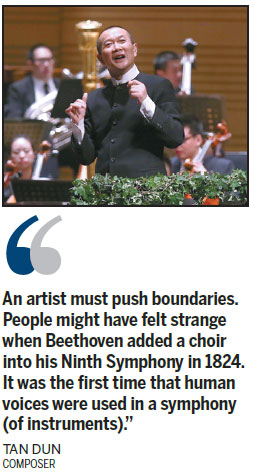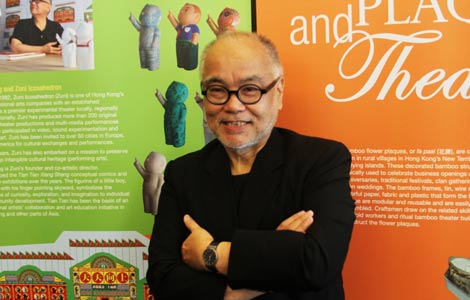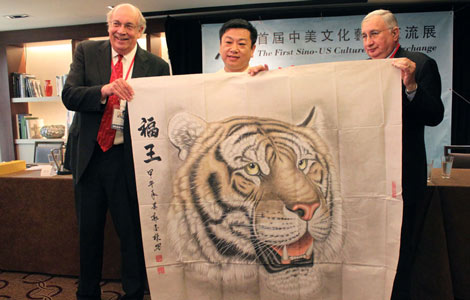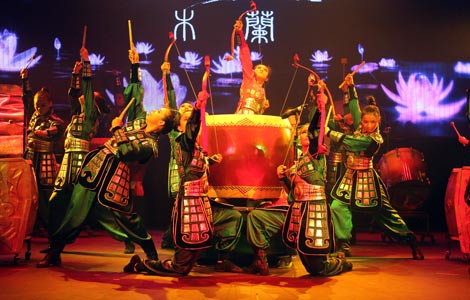Tan Dun turns edgy with WeChat chant
Updated: 2014-07-08 07:09
By Chen Jie (China Daily USA)
|
||||||||
Tan Dun is always ahead of the curve. Trained as a classical composer, he has created symphonies and operas, and made music with pretty much everything from water to paper. Tan has also documented nyushu, a written language only used by women in ancient China's central Hunan province and considered a dying heritage, and once worked with YouTube to organize an online orchestra.
In his latest project, Tan has used WeChat, a popular Chinese mobile messaging application, and audience chanting to enhance interaction between orchestras and audiences during live concerts in Beijing (with China Philharmonic Orchestra on July 1) and in Shanghai (with Shanghai Symphony Orchestra on July 4).
Earlier this year, Tan's long-time friend and conductor Yu Long (artistic director of both orchestras) invited him to celebrate Yu's 50th birthday on July 1 by creating something beautiful.
Tan, 57, wanted to make it "fun but meaningful".
Yu is a "thoughtful and ambitious" conductor who has devoted around 30 years of his life to promoting Western classical music in China and has tried to connect the country with cultural capitals around the world, according to Tan. Although Yu's mission has never been easy, Tan says that Yu has faced all challenges with "great wisdom and courage".

With that image of Yu in his mind, Tan kept murmuring Yu's given name "Long", when he remembered a familiar Peking Opera tune. He chanted the tune, "Long li ge long, long li ge long ... "
"It's a Chinese hippie-style chant that has pride, loneliness, helplessness and many other emotions that I think reflect Yu's own view of life," Tan told China Daily in a recent exclusive interview in Beijing.
Tan then thought of the form. How was he to present the chant?
One morning a few months ago, when he turned on his mobile phone and WeChat popped up, his inspiration was born.
Probably, the first thing most people do when they rise in the morning is to get on to social media on their cellphones. Tan is no exception to the rule with 7 million fans on Tencent's WeChat and 2.8 million fans on Sina Weibo. The composer shares his music and thoughts on WeChat every day.
While advocating the use of technology, Tan says that he believes smartphones play a key role in building ties between artists and audiences. "We classical musicians should not complain about losing audiences without making attempts to engage with them."
As a result of his efforts to modernize the performing arts, he created the Long Li Ge Long: A Symphonic Poem with Mobiles and Audience Chant.
Ahead of the concert, Tan released his own chanting of "long li ge long" over 41 seconds on his WeChat account.
During the two concerts, after conducting the orchestra to play the first part, a symphonic rearranged Long Li Ge Long, Tan turned to the audience and showed his open palm with five fingers stretched out.
After seeing the sign, the audience - as if on cue - clicked on WeChat to play Tan's pre-concert recording. The single tune, playing from hundreds of mobile phones, broke into a spell-binding chant to fill the concert halls in Beijing and Shanghai.
After the mobile chant was over, Tan encouraged the audience to chant together with members of the orchestra.
"It sounds like an ancient ritual in the modern era," says a young male student from the Tsinghua University who watched the concert in Beijing. "There is only one simple tune, but the variations were magical and so powerful that it made me very excited."
Tan says that the tune is ancient while the medium is modern. He wants to take people on a trip through ancient times with such ritualistic performances.
"I'm often criticized for being a maverick composer. No, I'm not. I'm just hungry for new sounds and forms," he says.
"An artist must push boundaries. People might have felt strange when Beethoven added a choir into his Ninth Symphony in 1824. It was the first time that human voices were used in a symphony (of instruments)."
An artist must push boundaries. People might have felt strange when Beethoven added a choir into his Ninth Symphony in 1824. It was the first time that human voices were used in a symphony (of instruments)."
chenjie@chinadaily.com.cn
(China Daily USA 07/08/2014 page8)

 'God father' of HK art honored for Smithsonian exhibit
'God father' of HK art honored for Smithsonian exhibit
 Grateful blessings
Grateful blessings
 Visitors tour Chinese warships
Visitors tour Chinese warships
 Chinese-American police officers rise in NYPD
Chinese-American police officers rise in NYPD
 The world in photos: June 30 - July 6
The world in photos: June 30 - July 6
 Chinese navy to join 2014 RIMPAC naval drill
Chinese navy to join 2014 RIMPAC naval drill
 Gettysburg reenactment marks 151st anniversary
Gettysburg reenactment marks 151st anniversary
 Washington splashed with fireworks
Washington splashed with fireworks
Most Viewed
Editor's Picks

|

|

|

|

|

|
Today's Top News
`God father’ of HK art honored for Smithsonian exhibit
Chinese envoy: 'Time is ripe' for BRICS' bank
US south benefitting from China investment
Talks may help US soy exports
Product placement deal transforms into dispute
China approves Lenovo, IBM $2.3b server deal
Meet the new breed of migrant workers
NetJets awaits green light to start China operations
US Weekly

|

|






